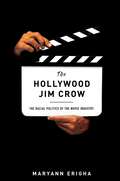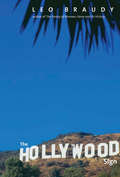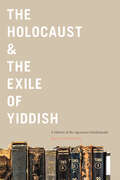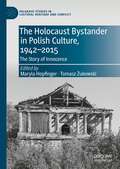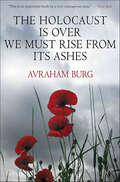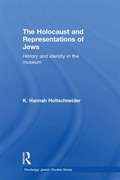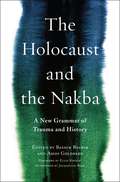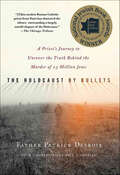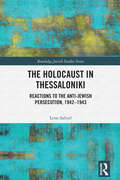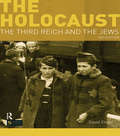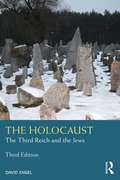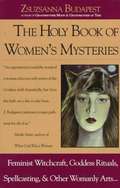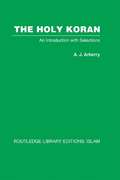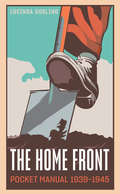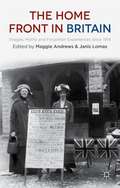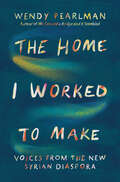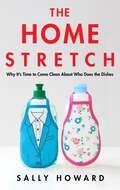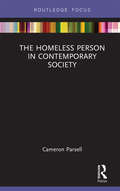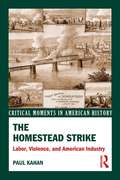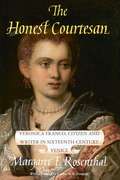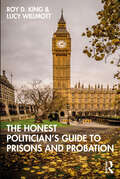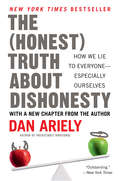- Table View
- List View
The Hollywood Jim Crow: The Racial Politics of the Movie Industry
by Maryann ErighaThe story of racial hierarchy in the American film industry The #OscarsSoWhite campaign, and the content of the leaked Sony emails which revealed, among many other things, that a powerful Hollywood insider didn’t believe that Denzel Washington could “open” a western genre film, provide glaring evidence that the opportunities for people of color in Hollywood are limited. In The Hollywood Jim Crow, Maryann Erigha tells the story of inequality, looking at the practices and biases that limit the production and circulation of movies directed by racial minorities. She examines over 1,300 contemporary films, specifically focusing on directors, to show the key elements at work in maintaining “the Hollywood Jim Crow.” Unlike the Jim Crow era where ideas about innate racial inferiority and superiority were the grounds for segregation, Hollywood’s version tries to use economic and cultural explanations to justify the underrepresentation and stigmatization of Black filmmakers. Erigha exposes the key elements at work in maintaining Hollywood’s racial hierarchy, namely the relationship between genre and race, the ghettoization of Black directors to black films, and how Blackness is perceived by the Hollywood producers and studios who decide what gets made and who gets to make it. Erigha questions the notion that increased representation of African Americans behind the camera is the sole answer to the racial inequality gap. Instead, she suggests focusing on the obstacles to integration for African American film directors. Hollywood movies have an expansive reach and exert tremendous power in the national and global production, distribution, and exhibition of popular culture. The Hollywood Jim Crow fully dissects the racial inequality embedded in this industry, looking at alternative ways for African Americans to find success in Hollywood and suggesting how they can band together to forge their own career paths.
The Hollywood Kid: The Violent Life and Violent Death of an MS-13 Hitman
by Oscar Martinez Juan MartinezThe compelling story of the life and death of a Salvadoran gangsterAs a boy, Miguel Ángel Tobar’s small town in El Salvador was torn apart by guerrillas and US- backed death squads. Still a preteen, he joined a different kind of death squad—the Hollywood Locos Salvatrucha—a clique of the Mara Salvatruchas, better known as MS-13. This international criminal organization began on the streets of Los Angeles in the 1980s, as Salvadoran children, whose families had fled their country’s civil war, banded together to defend themselves from LA gangs. Denied refugee status, the Salvadorans found themselves pushed into the shadows and besieged by violence, and MS-13 itself mutated into a gang. When large-scale US deportations began, violence was exported from the United States to El Salvador, helping make it one of the world’s deadliest countries and in turn propelling new waves of refugees northward. The Salvadoran journalist Óscar Martinez and his anthropologist brother Juan José Martínez got to know the Hollywood Kid when he informed on MS-13. In his hideaway shack, he recounted a life of killing—a death toll of more than fifty rival gang members—until his own murder ended the story. Vivid and violent, The Hollywood Kid brings a brutal world to life, illustrating the geopolitical forces propelling a country toward ever more vicious extremes.
The Hollywood Sign: Fantasy And Reality Of An American Icon (Icons of America)
by Leo BraudyThe story behind the massive white block letters set into a steep Los Angeles hillside—and the city and culture they represent: &“Terrific.&”—San Francisco Chronicle To so many who see its image, the Hollywood sign represents the earthly home of that otherwise ethereal world of fame, stardom, celebrity—the American and worldwide aspiration to be in the limelight, to be, like the Hollywood sign itself, instantly recognizable. How an advertisement erected in 1923, touting the real estate development Hollywoodland, took on a life of its own is a story worthy of a movie itself. Leo Braudy traces the remarkable life of this distinctly American landmark, which has been saved over the years by a various fans and supporters, among them Alice Cooper and Hugh Hefner, who spearheaded its reconstruction in the 1970s. He also uses the sign&’s history to offer an intriguing look at the rise of the film business from its earliest, silent days through the development of the studio system that helped define modern Hollywood. Mixing social history, urban studies, literature, and film, along with forays into such topics as the lure of Hollywood for utopian communities and the development of domestic architecture in Los Angeles, The Hollywood Sign is a fascinating account of how a temporary structure has become a permanent icon of American culture. &“An entertaining tale.&”—The Washington Post
The Holocaust & the Exile of Yiddish: A History of the Algemeyne Entsiklopedye
by Barry TrachtenbergIn the early 1930s in Berlin, Germany, a group of leading Eastern European Jewish intellectuals embarked upon a project to transform the lives of millions of Yiddish-speaking Jews around the world. Their goal was to publish a popular and comprehensive Yiddish language encyclopedia of general knowledge that would serve as a bridge to the modern world and as a guide to help its readers navigate their way within it. However, soon after the Algemeyne entsiklopedye (General Encyclopedia) was announced, Hitler’s rise to power forced its editors to flee to Paris. The scope and mission of the project repeatedly changed before its final volumes were published in New York City in 1966. The Holocaust & the Exile of Yiddish untangles the complicated saga of the Algemeyne entsiklopedye and its editors. The editors continued to publish volumes and revise the encyclopedia’s mission while their primary audience, Eastern European Jews, faced persecution and genocide under Nazi rule, and the challenge of reestablishing themselves in the first decades after World War II. Historian Barry Trachtenberg reveals how, over the course of the middle decades of the twentieth century, the project sparked tremendous controversy in Jewish cultural and political circles, which debated what the purpose of a Yiddish encyclopedia should be, as well as what knowledge and perspectives it should contain. Nevertheless, this is not only a story about destruction and trauma, but also one of tenacity and continuity, as the encyclopedia’s compilers strove to preserve the heritage of Yiddish culture, to document its near-total extermination in the Holocaust, and to chart its path into the future.
The Holocaust Bystander in Polish Culture, 1942-2015: The Story of Innocence (Palgrave Studies in Cultural Heritage and Conflict)
by Maryla Hopfinger Tomasz ŻukowskiThis book concerns building an idealized image of the society in which the Holocaust occurred. It inspects the category of the bystander (in Polish culture closely related to the witness), since the war recognized as the axis of self-presentation and majority politics of memory. The category is of performative character since it defines the roles of event participants, assumes passivity of the non-Jewish environment, and alienates the exterminated, thus making it impossible to speak about the bystanders’ violence at the border between the ghetto and the ‘Aryan’ side. Bystanders were neither passive nor distanced; rather, they participated and played important roles in Nazi plans. Starting with the war, the authors analyze the functions of this category in the Polish discourse of memory through following its changing forms and showing links with social practices organizing the collective memory. Despite being often critiqued, this point of dispute about Polish memory rarely belongs to mainstream culture. It also blocks the memory of Polish violence against Jews. The book is intended for students and researchers interested in memory studies, the history of the Holocaust, the memory of genocide, and the war and postwar cultures of Poland and Eastern Europe.
The Holocaust In American Life
by Peter NovickThis “courageous and thought-provoking book” examines how the Holocaust came to hold its unique place in American memory (Foreign Affairs).Prize–winning historian Peter Novick explores in absorbing detail the decisions that moved the Holocaust to the center of American life. He illuminates how Jewish leaders invoked its memory to muster support for Israel, and how politicians in turn used it to score points with Jewish voters. With insight and sensitivity, Novick raises searching questions about these developments, their meaning, and their consequences. Does the Holocaust really teach useful lessons and sensitize us to atrocities, or, by making the Holocaust the measure, does it make lesser crimes seem “not so bad”? Have American Jews, by making the Holocaust the emblematic Jewish experience, given Hitler a posthumous victory, tacitly endorsing his definition of Jews as despised pariahs? What are we to make of the fact that while Americans spend hundreds of millions of dollars for museums recording a European crime, while comparatively little is done to memorialize American slavery?A New York Times Notable Book
The Holocaust Is Over; We Must Rise From its Ashes
by Avraham BurgModern-day Israel, and the Jewish community, are strongly influenced by the memory and horrors of Hitler and the Holocaust. Burg argues that the Jewish nation has been traumatized and has lost the ability to trust itself, its neighbors or the world around it. He shows that this is one of the causes for the growing nationalism and violence that are plaguing Israeli society and reverberating through Jewish communities worldwide. Burg uses his own family history--his parents were Holocaust survivors--to inform his innovative views on what the Jewish people need to do to move on and eventually live in peace with their Arab neighbors and feel comfortable in the world at large. Thought-provoking, compelling, and original, this book is bound to spark a heated debate around the world.
The Holocaust and Representations of Jews: History and Identity in the Museum (Routledge Jewish Studies Series)
by K. Hannah HoltschneiderThe Holocaust and Representations of Jews examines how prominent national exhibitions in Europe represent the Jewish minority and its cultural and religious self-understandings, historically and today, in particular in the context of the Holocaust. Insights from the New Museology are brought to the field of Jewish Studies through an exploration of the visual representation of Jewish history and Jewish identifications in the display of photographs. Drawing on case studies which focus on the Holocaust Exhibition at the Imperial War Museum in London and the permanent exhibition at the Jewish Museum Berlin, these themes become the prism through which aspects of historiography and the display of the ‘otherness’ of minorities are addressed. Casting new light on the issues surrounding the visual representation of Jews, the work of museum practitioners in relation to historical presentations and to the use of photographs in exhibitions, this book is an important contribution not only to the fields of Jewish Studies, Religion and History, but also to the study of the representation of minority-majority relations and the understanding of exhibition visits as an educational tool.
The Holocaust and the Nakba: A New Grammar of Trauma and History (Religion, Culture, and Public Life #39)
by Jacqueline Rose Omer Bartov Gil Anidjar Alon Confino Yehouda Shenhav Mark Levene Hannan Hever Refqa Abu-Remaileh Omri Ben-Yehuda Tal Ben-Zvi Yochi Fischer Honaida Ghanim Mustafa Kabha Nadim Khoury Amnon Raz-Krakotzkin Raef ZreikIn this groundbreaking book, leading Arab and Jewish intellectuals examine how and why the Holocaust and the Nakba are interlinked without blurring fundamental differences between them. While these two foundational tragedies are often discussed separately and in abstraction from the constitutive historical global contexts of nationalism and colonialism, The Holocaust and the Nakba explores the historical, political, and cultural intersections between them. The majority of the contributors argue that these intersections are embedded in cultural imaginations, colonial and asymmetrical power relations, realities, and structures. Focusing on them paves the way for a new political, historical, and moral grammar that enables a joint Arab-Jewish dwelling and supports historical reconciliation in Israel/Palestine.This book does not seek to draw a parallel or comparison between the Holocaust and Nakba or to merely inaugurate a “dialogue” between them. Instead, it searches for a new historical and political grammar for relating and narrating their complicated intersections. The book features prominent international contributors, including a foreword by Lebanese novelist Elias Khoury on the centrality of the Holocaust and Nakba in the essential struggle of humanity against racism, and an afterword by literary scholar Jacqueline Rose on the challenges and contributions of the linkage between the Holocaust and Nakba for power to shift and a world of justice and equality to be created between the two peoples. The Holocaust and the Nakba is the first extended and collective scholarly treatment in English of these two constitutive traumas together.
The Holocaust by Bullets: A Priest's Journey to Uncover the Truth Behind the Murder of 1.5 Million Jews
by Patrick DesboisWinner of the National Jewish Book Award: The story of how a Catholic priest uncovered the truth behind the murder of more than a million Ukrainian Jews.Father Patrick Desbois documents the daunting task of identifying and examining all the sites where Jews were exterminated by Nazi mobile units in Ukraine in WWII. Using innovative methodology, interviews, and ballistic evidence, he has determined the location of many mass gravesites with the goal of providing proper burials for the victims of the forgotten Ukrainian Holocaust.Compiling new archival material and many eye-witness accounts, Desbois has put together the first definitive account of one of World War II’s bloodiest chapters. Published with the support of the United States Holocaust Memorial Museum.“This modest Roman Catholic priest from Paris, without using much more than his calm voice and Roman collar, has shattered the silence surrounding a largely untold chapter of the Holocaust.” —Chicago Tribune“Part memoir, part prosecutorial brief, The Holocaust by Bullets tells a compelling story in which a priest unconnected by heritage or history is so moved by an injustice he sets out to right a daunting wrong.” —The Miami Herald“Father Desbois is a generation too late to save lives. Instead, he has saved memory and history.” —The Wall Street Journal“An outstanding contribution to Holocaust literature, uncovering new dimensions of the tragedy . . . Highly recommended.” —Library Journal (starred review)
The Holocaust in Thessaloniki: Reactions to the Anti-Jewish Persecution, 1942–1943 (Routledge Jewish Studies Series)
by Leon SaltielThe book narrates the last days of the once prominent Jewish community of Thessaloniki, the overwhelming majority of which was transported to the Nazi death camp of Auschwitz in 1943. Focusing on the Holocaust of the Jews of Thessaloniki, this book maps the reactions of the authorities, the Church and the civil society as events unfolded. In so doing, it seeks to answer the questions, did the Christian society of their hometown stand up to their defense and did they try to undermine or object to the Nazi orders? Utilizing new sources and interpretation schemes, this book will be a great contribution to the local efforts underway, seeking to reconcile Thessaloniki with its Jewish past and honour the victims of the Holocaust. The first study to examine why 95 percent of the Jews of Thessaloniki perished—one of the highest percentages in Europe—this book will appeal to students and scholars of the Holocaust, European History and Jewish Studies.
The Holocaust: The Third Reich and the Jews
by David EngelFully revised and updated, this second edition includes: · A much expanded selection of original documents, many never before anthologised in English · Added treatment of the role of non-Germans in the Holocaust and the geographical variations in Jewish response · Additional consideration of the much-debated nexus between the Holocaust and modernity · A new section on how 'the Holocaust' developed as a distinct historical topic · Useful and informative Chronology, Who’s Who and Glossary David Engel’s book is a taut, compact narration that appeals to the intellect as much, if not more, than to the emotions. It is sure to be welcomed by students in departments of History, Politics and European Studies as well as by anyone trying to get to grips with this complex and far-reaching subject for the first time.
The Holocaust: The Third Reich and the Jews (Seminar Studies)
by David EngelThis book offers a survey of the encounter between the Third Reich and European Jewry. Pointing out the difficulties historians face in interpreting the ever-expanding documentary record, it includes treatment of the role of non-Germans in the Holocaust, consideration of the much-debated nexus between the Holocaust and modernity, and discussion on how 'the Holocaust' developed as a distinct historical topic. Fully updated, this new third edition incorporates the latest scholarly findings with expanded treatment of gendered aspects of the Holocaust, the Holocaust’s world historical contexts, the long-term history of Jewish-Christian relations, and thinking about the Holocaust’s contemporary relevance, as well as additional documents reflecting recent archival discoveries. Offering a concise narration that appeals to both the intellect and the emotions, the book enables students to gain a real understanding of the events of this catastrophic time. Including a useful selection of original documents (many never before anthologised in English), a chronology, glossary, and 'who’s who', David Engel’s book will be welcomed by anyone trying to get to grips with this complex and far-reaching subject.
The Holy Book of Women's Mysteries
by Zsuzsanna E. BudapestThe Holy Book of Women's Mysteries is essential for Pagans, feminists, and women seeking to learn more about the spiritual path as it relates to the feminine and the Goddess aspects of witchcraft and Wicca. This book is not about reinstating a matriarchy or tearing down patriarchy; it is about women's spirituality and its relationship with politics and lifestyle. Z. Budapest is one of the founding mothers of modern women's witchcraft, beginning with the establishment of Susan B. Anthony Coven in Los Angeles in 1971. She catapulted herself into the media spotlight when she was tried as a witch and found guilty in 1975 after being arrested on Venice Beach for reading tarot cards. She fought the charges and, after a nine year battle, won the right for every tarot reader to do so legally. The Holy Book of Women's Mysteries is a seminal text that contains invaluable information on Dianic witchcraft and spells, including everyday magick, sabbat rituals, and divination methods; a section on how vegetarian theories and politics relate to witchcraft and the feminine aspect; and a good deal of information on goddesses and how the patriarchal religions distorted old myths to serve their own needs. There are several unique and beautiful Rites of Passage for women and men that you don't often find, and Budapest's personal life stories are an equally valuable read, from her escape across the mountains from Communist Hungary to her fight for women's religious freedom upon moving to America.
The Holy Koran: An Introduction with Selections
by A.J. ArberryDespite being revered as the Holy Book by Muslims throughout the world, the Koran is the least known and least understood in the West of all the great religious books. In this volume A J Arberry examines this paradox and explains the qualities of the Koran which have made it acceptable to so many people. The selections have been chosen and arranged to illustrate the religious and ethical message of the Koran.
The Home Front Pocket Manual, 1939–1945 (The\pocket Manual Ser.)
by Lucinda GoslingThis compilation of WWII-era magazine articles is &“a really useful reference guide covering aspects of life in the 1940s . . . packed with information&” (Home Front History). This manual brings together articles from stylish contemporary magazines of Britain during the World War II era, including Britannia & Eve, the Illustrated Sporting and Dramatic News, and Tatler, on all aspects of life on the home front. These fascinating articles cover complying with black-out regulations; what to do with the family car; augmenting rationed foods and turning them into tasty meals; contributing to the war effort by keeping livestock, salvaging valuable materials, and growing food—all, of course, while remaining fashionable and keeping up appearances.
The Home Front in Britain
by Maggie Andrews Janis LomasThe Home Front in Britain explores the British Home Front in the last 100 years since the outbreak of WW1. Case studies critically analyse the meaning and images of the British home and family in times war, challenging prevalent myths of how working and domestic life was shifted by national conflict.
The Home I Worked to Make: Voices from the New Syrian Diaspora
by Wendy PearlmanWar forced millions of Syrians from their homes. It also forced them to rethink the meaning of home itself. In 2011, Syrians took to the streets demanding freedom. Brutal government repression transformed peaceful protests into one of the most devastating conflicts of our times, killing hundreds of thousands and displacing millions. The Home I Worked to Make takes Syria’s refugee outflow as its point of departure. Based on hundreds of interviews conducted across more than a decade, it probes a question as intimate as it is universal: What is home? With gripping immediacy, Syrians now on five continents share stories of leaving, losing, searching, and finding (or not finding) home. Across this tapestry of voices, a new understanding emerges: home, for those without the privilege of taking it for granted, is both struggle and achievement. Recasting “refugee crises” as acts of diaspora-making, The Home I Worked to Make challenges readers to grapple with the hard-won wisdom of those who survive war and to see, with fresh eyes, what home means in their own lives.
The Home Stretch: Why It's Time to Come Clean About Who Does the Dishes
by Sally HowardForty years of feminism and still women do the majority of the housework. Why?In fact, while women are making slow but steady gains on gender disparities in the workplace, at home the gap is widening - in the UK, the average heterosexual British woman puts in 12 more days of household labour per year than her male companion, while young American men are now twice as likely as their fathers to think a woman's place is in the home. And when 'having it all' so often means hiring a nanny or cleaner, is it something to aspire to? Sally Howard joins up with a cohort of feminist separatists, undertakes a day's shift with her Lithuanian cleaner, lives in a futuristic model home designed to anticipate our needs and meets latte papas and one-percent parents in this lively examination which combines history and fieldwork with her personal story. The Home Stretch is a fascinating investigation into how we got here and what the future could look like for feminism's final frontier: the domestic labour gap.
The Homeless Person in Contemporary Society
by Cameron ParsellThe homeless person is thought to be different. Whereas we get to determine our difference or sameness, the homeless person’s difference is imposed upon them and assumed to be known because of their homelessness. Exclusion from housing – either a commodity that should be accessed from the market or social provision – signifies the homeless person’s incapacities and failure to function in what are presented as unproblematic social systems. Drawing on a program of research spanning ten years, this book provides an empirically grounded account of the lives and identities of people who are homeless. It illustrates that people with chronic experiences of homelessness have relatively predictable biographies characterised by exclusion, poverty, and trauma from early in life. Early experiences of exclusion continue to pervade the lives of people who are homeless in adulthood, yet they identify with family and normative values as a means of imaging aspirational futures.
The Homestead Strike: Labor, Violence, and American Industry (Critical Moments in American History)
by Paul KahanOn July 6, 1892, three hundred armed Pinkerton agents arrived in Homestead, Pennsylvania to retake the Carnegie Steelworks from the company's striking workers. As the agents tried to leave their boats, shots rang out and a violent skirmish began. The confrontation at Homestead was a turning point in the history of American unionism, beginning a rapid process of decline for America’s steel unions that lasted until the Great Depression. Examining the strike’s origins, events, and legacy, The Homestead Strike illuminates the tense relationship between labor, capital, and government in the pivotal moment between Reconstruction and the Progressive Era. In a concise narrative, bolstered by statements from steelworkers, court testimony, and excerpts from Carnegie's writings, Paul Kahan introduces students to one of the most dramatic and influential episodes in the history of American labor.
The Honest Body Project: Real Stories and Untouched Portraits of Women & Motherhood
by Natalie McCainOnly 4 percent of women around the world consider themselves to be beautiful, according to research done by Dove, and twenty million women suffer from significant eating disorders at some point in their life—The Honest Body Project was created to combat this tragic problem of poor body image in our society. Founded by photographer Natalie McCain, this project is opening the eyes of women around the world and helping them to see the beauty both outside and inside of themselves. It is a collection of black and white portraits and stories, raw and untouched, from hundreds of women who have bared their hearts and souls to be a part of the project. Natalie tastefully photographs the women in their underwear, showing off their natural shapes and “imperfections.” There is no editing done after the fact, and the natural beauty of these women—from all backgrounds and walks of life—shines through the lens. Together, they create a beautiful, honest picture of both motherhood and what it means to be a woman. Topics include body image issues, breast cancer, depression (postpartum and otherwise), anxiety, bottle feeding versus breast feeding, aging, and more.The Honest Body Project is a breath of fresh air, breaking down walls and helping women learn that they are not alone in their hardships. It wants to help women everywhere contribute to a better world, and to learn to love themselves and appreciate their bodies for what they are: perfectly imperfect. It is time to celebrate the true form of women.
The Honest Courtesan: Veronica Franco, Citizen and Writer in Sixteenth-Century Venice (Women In Culture And Society Ser.)
by Margaret F. RosenthalThe Venetian courtesan has long captured the imagination as a female symbol of sexual license, elegance, beauty, and unruliness. What then to make of the cortigiana onesta—the honest courtesan who recast virtue as intellectual integrity and offered wit and refinement in return for patronage and a place in public life? Veronica Franco (1546-1591) was such a woman, a writer and citizen of Venice, whose published poems and familiar letters offer rich testimony to the complexity of the honest courtesan's position. Margaret F. Rosenthal draws a compelling portrait of Veronica Franco in her cultural social, and economic world. Rosenthal reveals in Franco's writing a passionate support of defenseless women, strong convictions about inequality, and, in the eroticized language of her epistolary verses, the seductive political nature of all poetic contests. It is Veronica Franco's insight into the power conflicts between men and women—and her awareness of the threat she posed to her male contemporaries—that makes her literary works and her dealings with Venetian intellectuals so pertinent today. Combining the resources of biography, history, literary theory, and cultural criticism, this sophisticated interdisciplinary work presents an eloquent and often moving account of one woman's life as an act of self-creation and as a complex response to social forces and cultural conditions. "A book . . . pleasurably redolent of Venice in the 16th-century. Rosenthal gives a vivid sense of a world of salons and coteries, of intricate networks of family and patronage, and of literary exchanges both intellectual and erotic."—Helen Hackett, Times Higher Education SupplementThe Honest Courtesan is the basis for the film Dangerous Beauty (1998) directed by Marshall Herskovitz. (The film was re-titled The Honest Courtesan for release in the UK and Europe in 1999.)
The Honest Politician’s Guide to Prisons and Probation
by Roy D. King Lucy WillmottThrough a comprehensive analysis of legislative and organisational changes and interviews with all the key players, The Honest Politician’s Guide to Prisons and Probation provides an authoritative account of the crisis which has gradually engulfed the prison and probation services since 1991. Setting out the nature and extent of the crisis, King and Willmott show how the Woolf agenda was overridden in a process of political churn, through explorations of the Conservative government until 1997, New Labour from 1997 to 2010 and the Coalition and Conservative governments since 2010. Uniquely, interviews with all surviving Home Secretaries and Justice Secretaries of the period include insightful and candid reflections upon their time in office, and how they saw the future. Views from both inside and outside the prisons and probation services are also explored, based on interviews with the Director Generals of the Prison Service and of the new National Probation Service, Chief Inspectors of Prisons and Probation and the four most recent Lord Chief Justices, including Lord Woolf himself. Concluding by drawing on this collective wisdom, King and Willmott set out what is needed for an effective and sustainable future. It is essential reading not just for those in Westminster, but also for practitioners in criminal justice, advocacy organisations, thinktanks and scholars and students in Criminology, Criminal Justice, British Politics and Public Policy.
The Honest Truth About Dishonesty: How We Lie to Everyone--Especially Ourselves (Ebook Bundle Ser.)
by Dan ArielyThe New York Times bestselling author of Predictably Irrational and The Upside of Irrationality returns with thought-provoking work to challenge our preconceptions about dishonesty and urge us to take an honest look at ourselves. Does the chance of getting caught affect how likely we are to cheat?How do companies pave the way for dishonesty?Does collaboration make us more honest or less so?Does religion improve our honesty?Most of us think of ourselves as honest, but, in fact, we all cheat. From Washington to Wall Street, the classroom to the workplace, unethical behavior is everywhere. None of us is immune, whether its the white lie to head off trouble or padding our expense reports. In The (Honest) Truth About Dishonesty, award-winning, bestselling author Dan Ariely turns his unique insight and innovative research to the question of dishonesty. Generally, we assume that cheating, like most other decisions, is based on a rational cost-benefit analysis. But Ariely argues, and then demonstrates, that its actually the irrational forces that we dont take into account that often determine whether we behave ethically or not. For every Enron or political bribe, there are countless puffed resumes, hidden commissions, and knockoff purses. In The (Honest) Truth About Dishonesty, Ariely shows why some things are easier to lie about; how getting caught matters less than we think; and how business practices pave the way for unethical behavior, both intentionally and unintentionally. Ariely explores how unethical behavior works in the personal, professional, and political worlds, and how it affects all of us, even as we think of ourselves as having high moral standards. But all is not lost. Ariely also identifies what keeps us honest, pointing the way for achieving higher ethics in our everyday lives. With compelling personal and academic findings, The (Honest) Truth About Dishonesty will change the way we see ourselves, our actions, and others.
